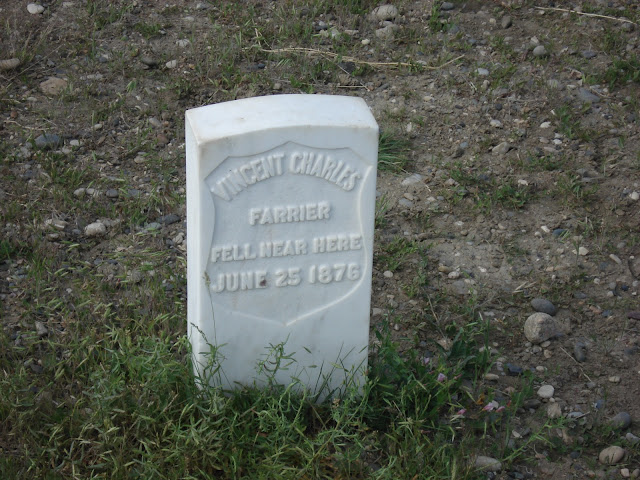 |
| Little Bighorn River Valley |
On our way home from Billings yesterday, my daughter, Anne Marie, and I stopped for a short tour of the battlefield where the tragic events popularly known as "Custer's Last Stand" took place. I am no fan of Col. Custer's. My sympathies tend to lie with the Indians on this one. That makes the events of June 25, 1876, no less tragic--for both sides. The battle victory went to the Indians. But the victory was followed by a lot of tragedy for the Indians, and they ended up on reservations anyway. I'm not going to try to retell that story; it's been done by others much better and with more complete information. I just want to reflect on my reaction to visiting this place.
First we toured the museum section of the Visitor's Center. It was a fascinating, sobering, and busy place. One tiny lady, who appeared to me to be American Indian, was wiping tears from her eyes as she looked at the exhibits, many of which were of the Indian people involved.
Then we took the drive through the battlefield. My first surprise was the extent of the area where the battles took place. The fighting spread over a three-to-five-mile stretch of hills and valleys. From things I had read in the past, I had a mental picture of the Custer attack and the fight involving the Reno/Benteen troops as being widely separate. At the site, it was clear that it was all part of one event. Custer made the mistake of ignoring the advice of his Indian scouts, who advised against attacking such a huge encampment, then he divided his troops. I suppose he thought he was going to attack from several directions. This did not work well for the small cavalry contingent. It worked great for the Indians, who had the numbers to surround the soldiers.
As we drove down the road, stopping at the numerous information stations, looking up from the illustrations to the actual hills and valleys, seeing the markers where combatants fell, a heavy lump of sorrow grew in my stomach. On a June day much like the one we were enjoying, these hills were full of the noise of battle, the smoke from the rifles clouded the air, men and horses screamed their battle cries, their pain, their fear, their death rattles. Blood soaked the hills.
And no good came from any of it. What a waste of lives, on both sides.
I was surprised by the strong emotional reaction I had to being there. It is a sorrowful place.
http://wiki.answers.com/Q/How_many_people_died_in_the_Battle_of_the_Little_Big_Horn)

We have stopped there quite a few times and it always sobers me.
ReplyDeleteLike my mom said we've visited the site many times over my life. I don't think I fully comprehended the experience until I was an adult with a history degree. I am so thankful that such a reminder exists.
ReplyDelete